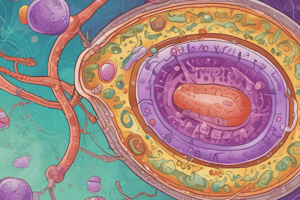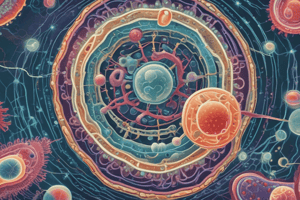Podcast
Questions and Answers
What is the primary function of the peptidoglycan layer in bacterial cell walls?
What is the primary function of the peptidoglycan layer in bacterial cell walls?
- To generate energy for the cell through photosynthesis
- To regulate the flow of substances in and out of the cell
- To provide shape, support, and protection to the cell (correct)
- To synthesize proteins for the cell
What is the term for the process by which bacteria use light as an energy source?
What is the term for the process by which bacteria use light as an energy source?
- Phototrophy (correct)
- Heterotrophy
- Chemotrophy
- Organotrophy
What is the primary component of the cell membrane in bacterial cells?
What is the primary component of the cell membrane in bacterial cells?
- Peptidoglycan
- Phospholipid bilayer (correct)
- Protein
- Carbohydrate
Which of the following is an example of a Gram-positive bacterial species?
Which of the following is an example of a Gram-positive bacterial species?
What is the term for the process by which bacteria use organic compounds as a carbon source?
What is the term for the process by which bacteria use organic compounds as a carbon source?
What is the primary function of flagella in bacterial cells?
What is the primary function of flagella in bacterial cells?
What is the term for the layer of peptidoglycan in Gram-positive bacterial cell walls?
What is the term for the layer of peptidoglycan in Gram-positive bacterial cell walls?
What is the primary function of pili in bacterial cells?
What is the primary function of pili in bacterial cells?
What is a characteristic of Staphylococcus bacteria?
What is a characteristic of Staphylococcus bacteria?
Which of the following is used to differentiate between Staphylococcus species?
Which of the following is used to differentiate between Staphylococcus species?
What is a concern with Staphylococcus aureus?
What is a concern with Staphylococcus aureus?
How are Streptococcus species typically identified?
How are Streptococcus species typically identified?
What is a characteristic of Streptococcus bacteria?
What is a characteristic of Streptococcus bacteria?
Which of the following is a concern with Staphylococcus aureus antibiotic resistance?
Which of the following is a concern with Staphylococcus aureus antibiotic resistance?
What is true about both Staphylococcus and Streptococcus bacteria?
What is true about both Staphylococcus and Streptococcus bacteria?
Which of the following is used to identify group A streptococci?
Which of the following is used to identify group A streptococci?
Flashcards are hidden until you start studying
Study Notes
Bacterial Cell Structure
- Cell Wall: Rigid layer outside the cell membrane, composed of peptidoglycan (also known as murein)
- Provides shape, support, and protection
- Cell Membrane: Semi-permeable membrane that regulates the flow of substances in and out of the cell
- Composed of phospholipid bilayer with embedded proteins
- Cytoplasm: Jelly-like substance inside the cell membrane, where metabolic reactions occur
- Contains ribosomes, DNA, and various organelles
- Flagella: Long, whip-like structures used for movement
- Located outside the cell wall and cell membrane
- Pili: Short, hair-like structures used for attachment and DNA transfer
- Located outside the cell wall and cell membrane
Metabolism
- Energy Sources: Bacteria can use various energy sources, including:
- Light (phototrophy)
- Chemical compounds (chemotrophy)
- Organic compounds (organotrophy)
- Carbon Sources: Bacteria can use various carbon sources, including:
- Organic compounds (heterotrophy)
- Carbon dioxide (autotrophy)
- Metabolic Pathways: Bacteria use various metabolic pathways, including:
- Glycolysis
- Pentose phosphate pathway
- Citric acid cycle
- Electron transport chain
Gram Positive Species
- Cell Wall Characteristics:
- Thick peptidoglycan layer (up to 40 layers)
- Teichoic acids and lipoteichoic acids present
- Staining Characteristics: Retain crystal violet dye during Gram staining
- Examples:
- Staphylococcus aureus
- Bacillus subtilis
- Clostridium difficile
Gram Negative Species
- Cell Wall Characteristics:
- Thin peptidoglycan layer (1-2 layers)
- Outer membrane present, containing lipopolysaccharides
- Staining Characteristics: Do not retain crystal violet dye during Gram staining
- Examples:
- Escherichia coli
- Pseudomonas aeruginosa
- Salmonella enterica
Bacterial Cell Structure
- Cell Wall: Composed of peptidoglycan (murein), providing shape, support, and protection to the cell.
- Cell Membrane: Semi-permeable, composed of phospholipid bilayer with embedded proteins, regulating the flow of substances in and out of the cell.
- Cytoplasm: Jelly-like substance containing ribosomes, DNA, and various organelles, where metabolic reactions occur.
- Flagella: Long, whip-like structures used for movement, located outside the cell wall and cell membrane.
- Pili: Short, hair-like structures used for attachment and DNA transfer, located outside the cell wall and cell membrane.
Metabolism
- Energy Sources: Bacteria can use light, chemical compounds, and organic compounds as energy sources.
- Carbon Sources: Bacteria can use organic compounds and carbon dioxide as carbon sources.
- Metabolic Pathways: Bacteria use glycolysis, pentose phosphate pathway, citric acid cycle, and electron transport chain for metabolism.
Gram Positive Species
- Characteristics: Thick peptidoglycan layer (up to 40 layers), teichoic acids and lipoteichoic acids present in the cell wall.
- Staining: Retain crystal violet dye during Gram staining.
- Examples: Staphylococcus aureus, Bacillus subtilis, and Clostridium difficile are Gram positive species.
Gram Negative Species
- Characteristics: Thin peptidoglycan layer (1-2 layers), outer membrane present with lipopolysaccharides.
- Staining: Do not retain crystal violet dye during Gram staining.
- Examples: Escherichia coli, Pseudomonas aeruginosa, and Salmonella enterica are Gram negative species.
Characteristics
- Staphylococcus: Gram-positive, spherical bacteria that are 0.5-1.5 μm in diameter and can grow in clusters or singly
- Staphylococcus: Catalase-positive, which distinguishes them from Streptococcus, and can produce a variety of enzymes and toxins
- Streptococcus: Gram-positive, spherical bacteria that are 0.5-1.0 μm in diameter and can grow in chains or pairs
- Streptococcus: Catalase-negative
Laboratory Diagnosis
- Staphylococcus: Cultured on blood agar, producing a golden-yellow pigment, and can be differentiated from other species using mannitol salt agar
- Staphylococcus: Coagulase testing can identify S.aureus
- Streptococcus: Cultured on blood agar, producing a clear or greenish zone, and can be identified using bacitracin sensitivity testing and Lancefield grouping
Antibiotic Resistance
- Staphylococcus: Methicillin-resistant S.aureus (MRSA) is a significant concern, with resistance to beta-lactam antibiotics, such as penicillin and ampicillin
- Staphylococcus: Vancomycin-resistant S.aureus (VRSA) has also been reported
- Streptococcus: Resistance to macrolides, such as erythromycin and azithromycin, and decreased susceptibility to penicillin and other beta-lactam antibiotics
- Streptococcus: Resistance to fluoroquinolones, such as ciprofloxacin and levofloxacin
Identification
- Staphylococcus: Identified by Gram stain, morphology, and biochemical tests, with species-specific identification using PCR, DNA-DNA hybridization, or MALDI-TOF
- Streptococcus: Identified by Gram stain, morphology, and biochemical tests, with Lancefield grouping and PCR for specific streptococcal groups
Gram Positive and Gram Negative Species
- Gram-positive species include Staphylococcus aureus, S.epidermidis, S.saprophyticus, Streptococcus pyogenes, S.agalactiae, and S.pneumoniae
- Both Staphylococcus and Streptococcus are gram-positive bacteria, with no gram-negative species
Studying That Suits You
Use AI to generate personalized quizzes and flashcards to suit your learning preferences.




